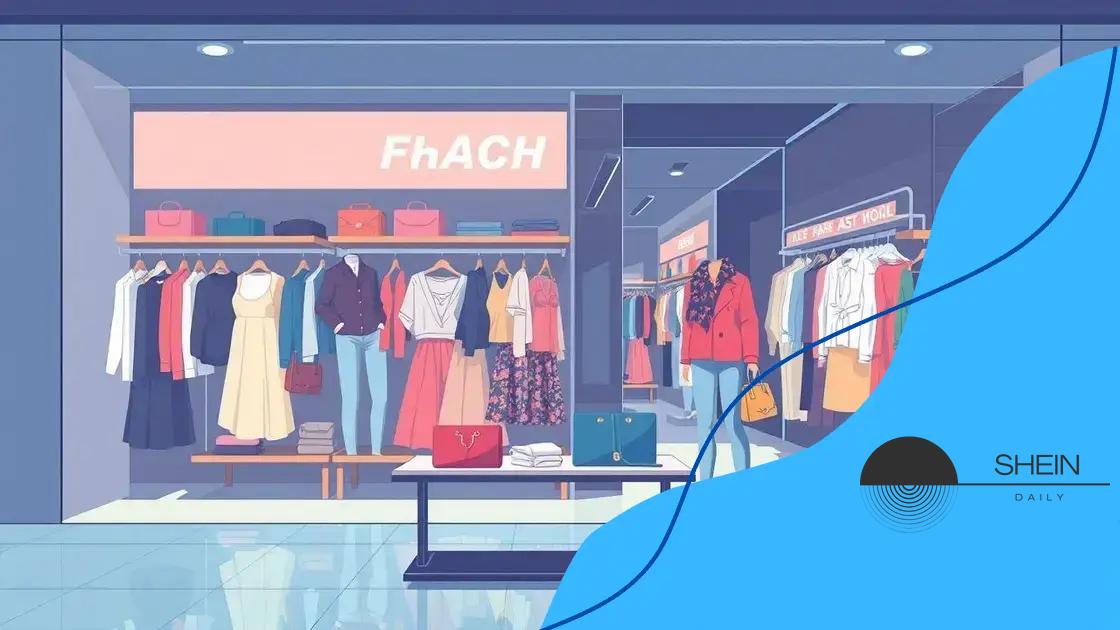Shein’s role in disrupting traditional retail economics

Shein’s role in disrupting traditional retail economics centers on its fast fashion model, which leverages rapid production and consumer data to redefine pricing, supply chains, and shopping behaviors, influencing future retail trends significantly.
Shein’s role in disrupting traditional retail economics is reshaping how we think about shopping. Have you considered how this brand’s approach changes the game for consumers and competitors alike?
Understanding Shein’s business model
Understanding Shein’s business model is crucial to grasping its impact on the retail landscape. This brand has revolutionized the traditional retail process by leveraging technology and consumer data.
How Shein Operates
Shein operates primarily as an online platform, focusing on speed and affordability. Their model is built on producing trendy items in small batches, which allows them to stay relevant in a fast-paced market. This approach minimizes risk and maximizes fresh offerings that appeal to consumers.
Key Elements of Shein’s Success
Several elements contribute to Shein’s success in the competitive fashion industry:
- Data-Driven Design: Shein collects extensive data on consumer preferences, helping them design and stock items that meet market demand.
- Fast Fashion: They specialize in quick turnarounds, moving from design to production in a matter of weeks.
- Social Media Marketing: Shein effectively uses social media platforms to connect with its audience, driving sales through influencer partnerships.
This combination of technology and marketing strategy positions Shein to adapt quickly to changing trends. By understanding consumer wants and needs, they can keep their catalog fresh and appealing. Furthermore, Shein’s competitive pricing model attracts price-sensitive shoppers, making them a formidable player in the fashion world. This adaptability and focus on consumer engagement are pivotal to their ongoing success.
Another key aspect is Shein’s global reach. The brand appeals to a diverse audience as it transcends geographical barriers. With localized websites and marketing strategies, they cater to specific markets effectively, while maintaining a cohesive brand identity globally.
Shein’s commitment to sustainability, though often questioned, also plays a role in its business model. They have started to integrate more eco-friendly practices as consumers increasingly prioritize sustainability in their shopping habits. This shift may influence how they position their products moving forward.
The impact of fast fashion on pricing
The impact of fast fashion on pricing is significant and has reshaped the retail landscape. Brands like Shein have influenced how consumers perceive value and affordability.
Changing Consumer Expectations
Fast fashion has created an expectation for low prices and constant new arrivals. Shoppers now anticipate quick trends and affordable options, which have become the norm in today’s market. This shift in expectations can pressure traditional retailers to adjust their pricing strategies quickly.
Price Wars and Competition
The competitive nature of fast fashion leads to price wars among retailers. Brands are continually trying to undercut each other, which can drive prices down. This pressure to offer lower prices affects not only marketing strategies but also production quality.
- Increased Accessibility: Consumers have more access to trendy clothing at prices that fit their budgets.
- Quality Concerns: Lower prices can often correlate with reduced quality, making durability a concern.
- Global Market Effects: As companies compete internationally, local brands may struggle to maintain their pricing.
Moreover, the fast fashion industry often uses cheaper materials and labor to keep prices down. This business model prioritizes speed and volume over sustainability, which can lead to ethical dilemmas among conscious consumers. With more awareness surrounding environmental issues, some shoppers are re-evaluating their relationships with fast fashion brands.
The fast fashion approach has also led to a rise in impulse buying. Shoppers are often tempted to purchase more items due to attractive pricing. This behavior contributes to increased consumption, which raises questions about consumer habits in a rapidly changing marketplace.
As prices continue to be driven down, it’s essential for retailers to find a balance between affordability and quality. Adapting to these changes requires innovation in both marketing and production strategies to meet consumer demands without sacrificing ethical considerations.
Consumer behavior in the age of Shein

Consumer behavior in the age of Shein has undergone notable changes, driven by the rapid evolution of online shopping and the allure of fast fashion.
The Rise of Online Shopping
With the rise of Shein, more consumers are turning to online platforms for their shopping needs. This shift allows for greater convenience and variety, enabling shoppers to browse an extensive range of options from the comfort of their homes. The ease of online shopping has reshaped how consumers make purchasing decisions.
Impulse Buying Trends
The fast fashion model encourages impulse buying, as consumers are often drawn to limited-time offers and trendy items. This phenomenon occurs because of Shein’s frequent new arrivals, making the shopping experience feel urgent and enticing.
- Social Media Influence: Platforms like Instagram and TikTok create a buzz around new trends, leading consumers to buy quickly.
- Affordability: Shein’s low prices make it easy for consumers to justify spontaneous purchases.
- Peer Pressure: Seeing friends or influencers wearing the latest trends can increase the desire to shop.
Another aspect of consumer behavior is the preference for trends over quality. Shoppers are increasingly inclined to buy numerous lower-quality items instead of investing in a few high-quality pieces. This trend is partly driven by the fast-paced nature of social media, where new styles emerge rapidly.
Furthermore, online reviews and ratings play a critical role in shaping consumer choices. Shoppers often seek feedback from other consumers before making a purchase. Shein’s interactive website allows users to leave reviews, enhancing trust and guiding purchasing decisions.
As sustainability becomes a growing concern, consumers are becoming more conscious of their impact. Some shoppers are starting to question the ethical implications of fast fashion and are seeking brands that align with their values. This shift in awareness could influence future purchasing behaviors.
Shein’s influence on supply chain dynamics
Shein’s influence on supply chain dynamics has transformed the way that fashion retail operates today. By adopting a model that focuses on speed and efficiency, Shein has set new standards for fast fashion, impacting various industry segments.
Production Speed
One of the most notable changes is the improvement in production speed. Shein can move from design to finished product in weeks, significantly faster than traditional retailers. This rapid turnaround allows Shein to respond quickly to trend shifts, ensuring that consumers find the latest styles available.
Just-In-Time Manufacturing
Shein has embraced just-in-time manufacturing, which reduces waste and lowers inventory costs. This approach minimizes unsold stock, which can be a significant issue in the fashion industry.
- Reduced Overproduction: Brands can produce only what is necessary, aligning supply closely with demand.
- Flexibility: Quick adjustments can be made if a particular style does not resonate with consumers.
- Cost Efficiency: Lower production costs result in better pricing for customers.
This streamlined supply chain model impacts traditional retailers who struggle to keep up with such agility. Competitors are forced to rethink their strategies to remain relevant in a market where speed is paramount.
Moreover, Shein’s global sourcing techniques have allowed them to tap into various manufacturing hubs worldwide. This diversity in sourcing helps mitigate risks associated with regional disruptions and maintains lower costs. However, such practices also raise ethical concerns regarding labor practices and environmental impact, prompting rising consumer awareness about sustainability.
Finally, Shein’s heavy reliance on data analytics allows them to forecast trends accurately. By analyzing consumer behavior in real-time, Shein anticipates demand, aligning production with what shoppers want. This data-driven approach is redefining how companies can utilize technology within their supply chains for competitive advantage.
Future trends in retail economics due to Shein
Future trends in retail economics due to Shein are likely to reshape the industry significantly. As fast fashion continues to dominate, it influences both consumer expectations and retail strategies.
Increased Emphasis on Sustainability
One key trend is the growing demand for sustainability. Consumers are becoming more aware of the environmental impact of their purchases, leading brands to adopt greener practices. Shein has started to address this issue, but as competition grows, more retailers will need to incorporate sustainability into their models.
Integration of Technology
Technological advancements are set to play a crucial role in the retail landscape. Companies like Shein are utilizing data analytics to predict trends and improve inventory management. Retailers will increasingly rely on technology to enhance customer experiences.
- Personalization: Brands will offer tailored shopping experiences based on data-driven insights.
- Augmented Reality: Tools that allow customers to try on clothes virtually may become standard.
- Seamless Checkouts: Enhanced payment solutions will streamline the purchasing process.
Additionally, the expansion of direct-to-consumer (DTC) models may disrupt traditional retail structures. DTC reduces the need for middlemen, allowing brands to connect directly with consumers. This change could lower costs and improve margins.
As more businesses adopt digital channels, competition will intensify. Retailers will have to engage customers through innovative marketing tactics, including social media campaigns and influencer partnerships. Shein’s ability to create buzz around their products shows how strong marketing can drive sales and brand loyalty.
In conclusion, the retail landscape is evolving rapidly due to Shein’s influence. The focus on sustainability, technological integration, and DTC models suggests a shift in how consumers interact with brands. As these trends develop, both established retailers and new entrants will need to adapt to stay competitive in this changing market.
In conclusion, Shein’s impact on retail economics is profound and multi-faceted. The brand has transformed consumer expectations, pushing for rapid fashion cycles and low prices. With growing emphasis on sustainability and technology, traditional retailers must adapt to stay relevant. As shopping continues to evolve, understanding these trends will be crucial for both consumers and businesses alike.
FAQ – Frequently Asked Questions about Shein’s Impact on Retail Economics
How has Shein changed consumer expectations in fashion?
Shein has set a new standard for fast fashion, leading consumers to expect rapid product turnover and lower prices.
What role does sustainability play in future retail trends?
Sustainability is becoming crucial as consumers increasingly demand eco-friendly practices from brands, pushing retailers to adapt.
How is technology influencing retail strategies today?
Technology is enhancing the consumer experience through personalized shopping options and efficient inventory management, allowing brands to better meet customer needs.
What is the significance of direct-to-consumer models in retail?
Direct-to-consumer models eliminate middlemen, allowing brands to connect directly with customers, which can lower costs and increase customer loyalty.





